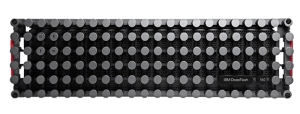DancingDinosaur has been cheerleading the z as a cloud player since 2011 and even before, mainly as an ideal vehicle for private clouds. So it should be no surprise to readers that last week IBM announced z and Power cloud-ready systems, services, and solutions for the hybrid cloud environment. My only question: What took them so long?

Power and z accelerate transformation to hybrid cloud
The world, indeed, is changing fast, and IT data centers especially have to scramble to keep up as they try to blend public cloud, private cloud, and traditional IT data centers and integrate it all seamlessly. “Today’s business environment is very dynamic and filled with disruption. A hybrid cloud model enables clients to continuously adapt while also optimizing on-premises investments and delivering the flexibility clients need across IBM Systems and the cloud,” according to Tom Rosamilia, senior vice president, IBM Systems.
At the heart of the IBM’s systems for what it calls the hybrid cloud era are three technologies we should be generally already familiar:
- z Systems for cloud. IBM z Systems Operational Insights is a new SaaS-based offering that provides analytic insights on cloud operations for new levels of efficiency and application performance. It allows users to make better business and application decisions based on trends and embedded expertise on performance data through a GUI dashboard. This accompanies IBM OMEGAMON Application Performance Management, which provides quick identification of problem components through end-to-end visibility for clients’ hybrid workloads that include z Systems applications. In addition, the newly available IBM Common Data Provider enables z Systems operational data to be efficiently consumed in near real time by the clients’ cloud or local enterprise operational analytics platform. An OK start, but you can quibble with OMEGAMON as IBM’s performance analysis and management choice. At its core, this is old technology. DancingDinosaur would prefer, say, Watson.
- Power Systems for cloud. With integrated OpenStack-based cloud management and elastic consumption models, according to IBM, these new enterprise-class IBM Power Systems enable organizations to transform their IT infrastructure to a local cloud for AIX, IBM i and Linux workloads and extend them with rapid access to compute services in the IBM Cloud. DancingDinosaur covered the new LC here.
- IBM Spectrum Copy Data Management and Protect. This brings a new solution that drives operational and development agility and efficiency across new and traditional applications that allow detailed, easy management of data copies. Additionally, IBM Spectrum Protect has expanded its extensive hybrid cloud solution integration with cloud object storage options for use in hybrid cloud deployments.
About the only thing missing above is LinuxONE but that will come up below when IBM gets to openness, which is critical to hybrid clouds. In its announcement, IBM also promised a series of new and expanded collaborations with IBM Systems for hybrid cloud environments, including:
- Canonical: Canonical and IBM are extending their ongoing alliance to make Ubuntu OpenStack available today on LinuxONE, z Systems, Power Systems, and OpenPOWER-based systems, including the new line of LC servers. This enables organizations to leverage Canonical’s portfolio across the three platforms with simplified and automated OpenStack management.
- Hortonworks: IBM and Hortonworks, a Hadoop platform, are jointly entering the marketplace to make Hortonworks Hadoop distribution available on POWER. Whoopee, Hadoop already runs native on z.
- Mirantis: Mirantis and IBM are collaborating to develop reference architectures enabling Mirantis OpenStack to manage compute nodes hosted on IBM Power Systems servers, and to validate a host of core applications to run its OpenStack private cloud. With this integration, Mirantis will now bring its OpenStack based private cloud management to the POWER platform. This enables organizations to leverage the efficiency of IBM Power Systems for data-driven workloads in a seamless and compatible way for their data center through Mirantis’ OpenStack cloud management.
- NGINX: NGINX’s application delivery platform now supports servers based on IBM’s POWER architecture with the latest release of its commercial load balancer and web accelerator software, NGINX Plus R10. The combination of NGINX Plus and POWER brings new agility to enterprises, allowing them to scale their infrastructure and application delivery solutions across any environment – public, private, and hybrid cloud; containers; and bare metal – providing a consistent user experience.
- Red Hat: Red Hat and IBM are expanding their long-standing alliance to better help organizations embrace hybrid cloud. Through joint engineering and deeper product collaboration, the two companies plan to deliver solutions built on key components of Red Hat’s portfolio of open source products, including Red Hat Enterprise Linux, (RHEL)., By the way, RHEL is the #2 Linux distro on the z. RHEL also enables IBM Power Systems as a featured component of Red Hat’s hybrid cloud strategy spanning platform infrastructure located both on and off an enterprise’s premises.
There is enough openness to enable you to do what you need so DancingDinosaur has no real complaints with IBM’s choices above. Just wish it was more z- and LinuxONE-centric.
DancingDinosaur is Alan Radding, a veteran information technology analyst and writer and mainframe bigot. Please follow DancingDinosaur on Twitter, @mainframeblog. See more of his IT writing at technologywriter.com and here.
 IBM DeepFlash 150, courtesy of IBM
IBM DeepFlash 150, courtesy of IBM